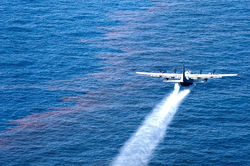Scientists confirm Gulf residents' claims about oil dispersant dangers
 Anyone who spent time talking to residents of coastal communities along the Gulf of Mexico following last year's BP oil disaster inevitably heard concerns about the widespread spraying of chemical dispersants to break up the oil slick.
Anyone who spent time talking to residents of coastal communities along the Gulf of Mexico following last year's BP oil disaster inevitably heard concerns about the widespread spraying of chemical dispersants to break up the oil slick.Residents worried that, rather than easing the ecological impact, the chemicals would in fact make the disaster worse by spreading the oil throughout the water column. They were also concerned about the toxicity of the dispersants, which are themselves petroleum-based.
As it turns out, science is justifying their fears.
According to preliminary findings presented at a conference last week by researchers from the University of West Florida, the dispersants may not have been effective -- and could actually be more harmful to the ecosystem than the oil alone, the Pensacola News Journal reports:
When mixed with oil, Corexit, the chemical dispersant used by BP, is toxic to phytoplankton and bacteria -- crucial elements in the Gulf of Mexico's fragile food chain, said Wade Jeffrey, a UWF biologist with the Center for Environmental Diagnostics and Bioremediation.BP used nearly 2 million gallons of Corexit on the almost 200 million-gallon oil spill, claiming it would break up the oil and allow bacteria to digest it. But the scientists challenge that claim, saying that Corexit does not in fact appear to speed up hydrocarbon breakdown. The ongoing research is being funded by a $10 million grant from BP.
"That (effect) may cascade itself up through other larger organisms as you go up the food web," he said Tuesday. "It's one of those small pieces of a big puzzle of effects. We can't say if we've seen big shifts yet. I don't know that answer yet."
Other research presented at the conference by Susan Laramore of Florida Atlantic University looked at how oil and dispersants are affecting shrimp, oysters and conch. It found that younger sea creatures are more sensitive to dispersed oil than their older counterparts.
These revelations come on the heels of research by UCF scientist Graham Worthy that suggested the BP oil and dispersants may be contributing to the unusually high number of dolphin deaths in the Gulf this year. So far, 153 bottlenose dolphin carcasses have washed up along the coast; 65 of them were either newborn, stillborn, born prematurely or infants.
Worthy said that several factors may be coming together to create a "perfect storm." One of those factors is unusual cold, and another is the oil and dispersant mix.
"The cold was a very unusual circumstance, but one which dolphins can normally survive, but we may also be seeing an indirect effect stemming from the BP oil spill," he said. "If oil and the dispersants have disrupted the food chain, this may have prevented the mother dolphins from getting adequate nutrition and building up the insulating blubber they needed to withstand the cold. That type of stress could ultimately have resulted in calves dying."
Cleanup workers and coastal residents say they have experienced health problems as a result of exposure to the oil and dispersants. The National Institutes of Health launched a study last year that's looking at health impacts in cleanup workers.
Tags
Sue Sturgis
Sue is the former editorial director of Facing South and the Institute for Southern Studies.
